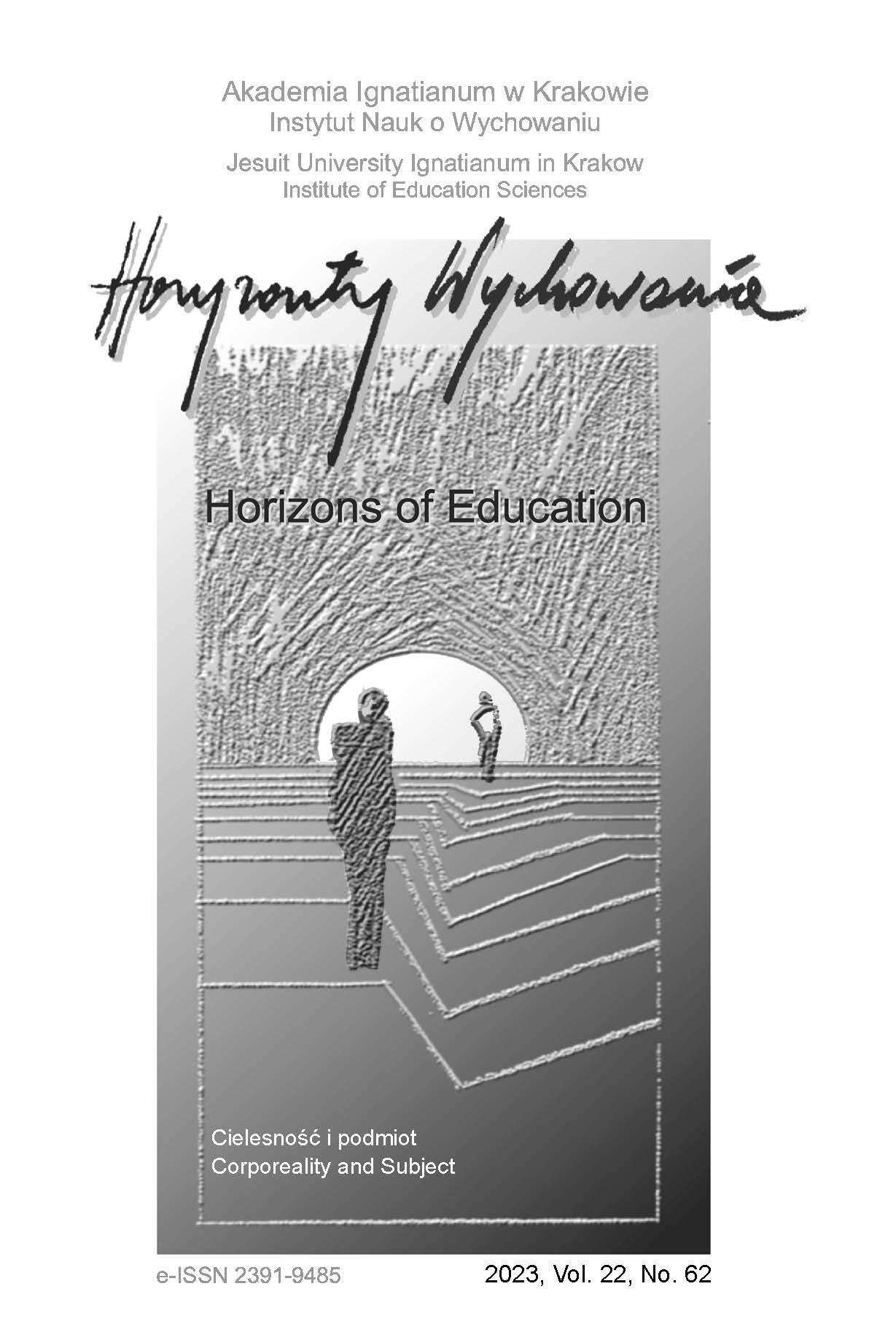Corporeality Affected by the Loss of a Loved One – Manifestations of the Body in the Experiences of Former Wards of Social Rehabilitation Centers
Abstract
RESEARCH OBJECTIVE: The aim of the study was to investigate the bodily dimension of the loss of a loved one and ways of dealing with such an experience manifested in action.
THE RESEARCH PROBLEM AND METHODS: The main research problem was formulated as a question: How do former wards of social rehabilitation centers experience and what meaning do they assign to the death of a loved one? The study used the biographical method, while the autobiographical narrative interview was used for data acquisition.
THE PROCESS OF ARGUMENTATION: The theoretical framework of this study on the boundary situation of the death of a loved one is Karl Jasper’s approach as well as Edith Stein’s theory of empathy, from which analytical codes were derived was discussed.
RESEARCH RESULTS: The death of a loved one experienced as a loss generates feelings that manifest in bodily forms of expression. The suffering resulting from the loss led to the development of new patterns of action: escapist and developmental-escapist.
CONCLUSIONS, INNOVATIONS, AND RECOMMENDATIONS: The basic conclusion is that the loss of a love one as a boundary situation, when one is not looked after and lives alone leads to abnormal social functioning. Thus, such experiences should arouse a great deal of attention from people caring for children and youth.
References
Bergman, A., Axberg, U. & Hanson, E. (2017). When a parent dies – a systematic review of the effects of support programs for parentally bereaved children and their caregivers. BMC Palliative Care, 16, 39. https://doi.org/10.1186/s12904-017-0223-y
Björkenstam, E., Burström, B., Hjern, A., Vinnerljung, B., Kosidou, K. & Berg, L. (2019). Cumulative childhood adversity, adolescent psychiatric disorder and violent offending in young adulthood. European Journal of Public Health, 29(5), 855-861. https://doi.org/10.1093/eurpub/ckz089
Cieślikowska-Ryczko, A. (2021). Badania biograficzne rodzin więźniów. Refleksja metodologiczna. Kwartalnik Pedagogiczny, 66(2),135-162.
Feigelman, W., Rosen, Z., Joiner, T., Silva, C., & Mueller, A.S. (2017): Examining longer-term effects of parental death in adolescents and young adults: Evidence from the national longitudinal survey of adolescent to adult health. Death Studies, 41(3), 133-143. https://doi.org/10.1080/07481187.2016.1226990
Flick, U. (2010). Projektowanie badania jakościowego (P. Tomanek, Trans.). Wydawnictwo Naukowe PWN.
Jaros, A. (2022). Naznaczone. Radzenie sobie z etykietowaniem w narracjach byłych wychowanek placówek resocjalizacyjnych. Wydawnictwo Uniwersytetu Łódzkiego.
Jaspers, K. (1978). Sytuacje graniczne (A. Staniewska & M. Kwieciński, Trans.). In R. Rudziński (Ed.), Jaspers (pp. 186-242). Wiedza Powszechna.
Korn, L., Bonny-Noach, H., Tesler, R., Koren, G. & Nissanholtz-Gannot, R. (2022). Risk and protective factors associated with multiproblem behaviours of Ethiopian young adults in Israel. Health & Social Care in the Community, 30(4), e1157-e1169. https://doi.org/10.1111/hsc.13523
Lewandowska, H. (2021). Objawy i przyczyny zagrożenia niedostosowaniem społecznym dzieci w wieku przedszkolnym. Journal of Modern Science, 46(1), 175-189. https://doi.org/10.13166/jms/139247
Łoś, M. (2011). Diagnoza pozytywna. Studium indywidualnego przypadku osoby odpornej. In W. Janik
(Ed.), Resilience. Teoria, badania, praktyka (pp. 67-86). Wydawnictwo Edukacyjne Parpamedia.
Mietelski, T. (2018). Interpretacja ciała ludzkiego w ujęciu Edyty Stein. Warszawskie Studia Teologiczne, 31(4), 78-93. https://doi.org/10.30439/WST.2018.4.5
Okupnik, M. (2018). W niewoli ciała. Doświadczenie utraty zdrowia i jego reprezentacje. TAiWPN Universitas.
Pasternak, E., Paśnik, K. & Plewka, N. (2015). Uzależnienie od opiatów – etiopatogeneza, rozpoznawanie i leczenie oraz ważna rola pielęgniarki. Pielęgniarstwo i Zdrowie Publiczne, 5(2), 209-214.
Polak, K. (2015). Sytuacje graniczne – szczególne spotkanie pedagogiki i pedagogii. In: J. Wiśniewska (Ed.), Sytuacje graniczne w biegu ludzkiego życia (pp. 24-32). Wydawnictwo Naukowe Instytutu Technologii Eksploatacji – Państwowy Instytut Badawczy.
Rubacha, K. (2008). Metodologia badań nad edukacją. Wydawnictwa Akademickie i Profesjonalne.
Rychter, K. (2019). Sytuacja kobiet w ciąży wysokiego ryzyka jako przykład sytuacji granicznej – inspiracje Jaspersowskie. Edukacja Filozoficzna, 67, 181-206. https://doi.org/10.14394/edufil.2019.0010
Schütze, F. (2012). Analiza biograficzna ugruntowana empirycznie w autobiograficznym wywiadzie narracyjnym. Jak analizować autobiograficzne wywiady narracyjne (K. Waniek, Trans.). In K. Kaźmierska (Ed.), Metoda biograficzna w socjologii. Antologia tekstów (pp. 141-278). Zakład Wydawniczy „Nomos”.
Skarga, B. (2002). Ślad i obecność. Wydawnictwo Naukowe PWN.
Stein, E. (2014). O zagadnieniu wczucia (D. Gierulanka & J.F. Gierula, Trans.). Wydawnictwo Karmelitów Bosych.
Stone, A.G., Lloyd, C.D. & Serin, R.C. (2021). Dynamic risk factors reassessed regularly after release from incarceration predict imminent violent recidivism. Law and Human Behavior, 45(6), 512-523. https://doi.org/10.1037/lhb0000463
Walczak, A. (2021). Ciało i cielesność – ku doświadcze(a)niu egzystencjalnemu. Humaniora, 35(3), 13-29. https://doi.org/10.14746/h.2021.3.1
Copyright (c) 2023 HORIZONS OF EDUCATION

This work is licensed under a Creative Commons Attribution-NoDerivatives 4.0 International License.
Authors who publish in this journal agree to the following terms:
- Authors retain the copyright to their work while granting the journal the right of first publication. The work will be simultaneously licensed under a CC BY-ND license, which permits others to share the work with proper credit given to the author and the original publication in this journal.
- Authors may enter into additional, non-exclusive agreements for the distribution of the published version of the work (e.g., posting it in an institutional repository or publishing it in another journal), provided that the original publication in this journal is acknowledged.
We allow and encourage authors to share their work online (e.g., in institutional repositories or on personal websites) both before and during the submission process, as this can foster beneficial exchanges and lead to earlier and increased citations of the published work. (See The Effect of Open Access). We recommend using any of the following academic networking platforms:





